November 6, 2018 Ryukyu Shimpo
By Shoichiro Yonamine
Just over a month since taking office, Okinawa Governor Denny Tamaki will set out on his first trip to the United States.
The newly elected governor will visit New York and Washington D.C. as part of a five-day trip from November 11-15.
While this part of the year is packed with duties such as year-end budget requests and prefectural assembly meetings, Governor Tamaki’s strong motivations are leading him to prioritize the trip to the U.S. The governor, whose birth is also in the spotlight as the U.S. is homeland of his father, a U.S. Marine who was stationed in Okinawa, aims to tell the international community about the Henoko base relocation issue.
In the gubernatorial election, Tamaki claimed, “My father’s country, a democracy, will not be able to reject me,” and said that he, “definitely,” intended to visit the U.S. The results of the election were widely covered by the mainstream U.S. media.
The New York Times ran the headline, “U.S. Marine’s Son Wins Okinawa Election on Promise to Oppose Military Base,” and indicated that, “His victory poses a setback to plans by the Japanese government and the United States,” to relocate MCAS Futenma.
Tamaki’s predecessor, the late Governor Takeshi Onaga, made his first visit to the United States roughly five months after taking office.
Prior to making his trip, he held a rally dubbed, “70 years after the [Pacific] war, stop new Henoko base construction! Okinawa Citizens Rally,” where the Shimagurumi Committee Leadership Council as well as other organization heads released a resolution supporting the former governor’s demands.
Governor Tamaki will be joined on his visit by six staff members.
The governor’s office released a statement indicating that the governor was hoping to visit the U.S. quickly after taking office to make use of the high amount of interest post-election, stating, “While we would still like a little more preparation time having just secured the election, the governor has an idea on timing and possible destinations.”
Meanwhile, on November 6 the U.S. will hold their midterm elections for both houses of Congress.
Since the visit will happen just after these elections, the political landscape and potential individuals to meet with is still fluid.
Governor Tamaki said, “From a schedule standpoint it is going to be tight, but I want the chance to get my message out to the media and the internet.”
For Governor Tamaki, who faces the Japanese government’s hardline stance pushing land-filling in Henoko Bay, he hopes that raising awareness in the international community will gain support for dialogue with both the Japanese and American governments.
Prior to leaving for the U.S., Governor Tamaki is scheduled to give a speech at the Foreign Correspondents Club of Japan, and he will make his “diplomatic debut,” with an appeal to the foreign press in Tokyo.
(English translation by T&CT and Sam Grieb)
Go to Japanese
November 2, 2018 Ryukyu Shimpo
The re-opening of construction at Henoko is the exact opposite of what was explained by Prime Minister Abe Shinzo when he said in a policy speech, “We will embrace the hearts of everyone in Okinawa.”
The Okinawa Defense Bureau (ODB) has re-started land-filling activity as part of the plan to relocate MCAS Futenma to Henoko Bay in Nago, Okinawa.
A float indicating the water in the bay as a temporary restricted area as well as an anti-pollution covering has been installed in the bay.
The government is planning to start filling the bay with sand this month.
Okinawa Governor Denny Tamaki is requesting a consultation with the government, however the government has already re-started construction as if to say, “There is no use in arguing.”
Does the government expect more and more people to see this show of overwhelming force and simply give up, thinking there is no fighting the government?
Without a doubt, this is the behavior of a conqueror.
It brings into doubt the foundation of Japan’s democracy.
The landfilling itself, was approved by a previous governor, and said approval was revoked by Governor Tamaki’s predecessor, the late Takeshi Onaga, on August 31.
The legal justification for the construction was at that time lost, and construction stopped.
In this year’s gubernatorial election, Governor Tamaki, who vocally opposed new base construction, won in a landslide, however the government is not respecting the will of Okinawa’s residents.
Instead, the Ministry of Defense filed a lawsuit demanding the Minister of Land, Infrastructure, Transport, and Tourism review the approval revocation using the Administrative Appeal Act as a legal foundation, and additionally, filed a petition to cancel the efficacy of the revoked approval preventing them from restarting construction without waiting for the result of the review.
The Administrative Appeal Act used as the legal basis for the lawsuit, was passed with the intention of being used by private individuals against government organizations. For the government to refer to itself as a private individual and file suit against a government body within its own country is a heavy-handed strategy many legal scholars consider illegal.
Only 13 days after the filing of the suit, the Minister of Land, Infrastructure, Transport, and Tourism received an objection from Okinawa Prefecture, but only 5 days after that decided to suspend the land-filing approval revocation.
The construction is continuing as planned despite objections.
The standoff over Henoko between the governments of Japan and Okinawa is not a problem for Okinawa alone.
The Japanese government has trampled the will of the people of Okinawa with an iron fist in order to build a base for the U.S. military.
It sets a dangerous precedent of allowing the government do whatever they want under the guise of national policy.
For example, take the Japanese government’s plan to install the Aegis Ashore missile defense system in Akita and Yamaguchi Prefectures.
Prime Minister Abe has said that, “Having the understanding of the regions is a major premise. We will continue to respectfully respond to any worries or requests.” However, despite all of the “respect” and “humility,” at the end of the day is not still the wielding of a heavy hand?
The same could be said for the permanent disposal of highly radioactive waste.
While claiming a decentralization of authority, the government continues to ignore the voices of the people who live in those regions, and the carrot-and-stick methods used by the Abe administration to shut out their opponents needs to be stopped.
To that end, the people of Japan need to learn about the Henoko issue, and raise their voices to let the government know that this is not normal.
In the Okinawa gubernatorial election, the candidate backed by the Liberal Democratic Party (LDP) and Komeito was said to embrace the central government, and ran a campaign with overwhelming resources and personnel, however the people of Okinawa rejected their “conqueror” and elected Denny Tamaki by a historic margin.
The Abe administration must listen to the message being sent by the people of Okinawa.
(English translation by T&CT and Sam Grieb)
Go to Japanese
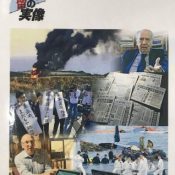
November 2, 2018 Ryukyu Shimpo
Waseda University announced the award-winning pieces for the 18th Waseda Journalism Award in Memory of Ishibashi Tanzan on November 1.
This award is dedicated to the legacy of former prime minister and journalist Tanzan Ishibashi who graduated from Waseda University, and honors journalists who make contributions to society, culture, and the public.
A series of reports composed by Ryukyu Shimpo reporter Ryota Shimabukuro, which center around the “Realities of U.S. stationing in Okinawa,” won the Public Service Section of the Waseda Journalism Award.
This is the fourth time Ryukyu Shimpo’s work has received this award, and the first time it has done so in three years.
Waseda Journalism Award selection committee members assessed that the series, “Presents the reality that Japan has forgotten its independence and instead makes Okinawa scapegoat to the U.S.-Japan Status of Forces Agreement, which the Japanese government and many Japanese citizens see as a natural conclusion.”
The “Realities of US Stationing in Okinawa” series (which ran from November 19, 2017 through June 9, 2018) throws into relief the way in which Okianwans’ lives are threatened by U.S. influence such as incidents, accidents, aircraft noise, and environmental pollution.
Meanwhile, Okinawa is unable to exercise adequate authority in Japan to combat these problems.
The series even compares U.S. base issues in Okinawa to U.S. military involvement in other countries.
There were winners aside from the “Realities of U.S. Stationing in Okinawa” in the Public Service Section.
These were a series of reports by the Asahi Shimbun and Asahi Shimbun Digital that questioned the government’s approach to disclosure of information in regards to the Moritomo Gakuen and Kake Gakuen scandals, and an NHK special on the Battle of Imphal.
In the Grassroots Democracy Section, the selection committee chose a report by a group of experts on what the Self-Defense Force witnessed in South Sudan, based on undisclosed SDF daily logs.
In total there were 183 entries up for consideration for the Waseda Journalism Award in Memory of Ishibashi Tanzan.
(English translation by T&CT and Erin Jones)
Go to Japanese
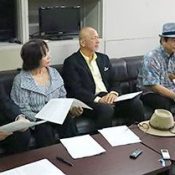
October 31, 2018 Ryukyu Shimpo
On October 30, five Okinawan researchers including University of the Ryukyus professors Hiroto Tokuda and Masaaki Gabe held a press conference and released a statement criticizing the Okinawa Defense Bureau for requesting that the Minister of Land, Infrastructure, Transport, and Tourism suspend revocation of the land reclamation permit.
The statement said, “The Defense Bureau’s conduct violently trampled the democratic local autonomy guaranteed by the Constitution.”
Sixty-seven researchers and professors in Okinawa specializing in law, sociology, and natural sciences signed onto this statement, including some from the University of the Ryukyus.
Volunteers visited the Okinawa Defense Bureau to personally deliver the statement and urge that the permit revocation be reinstated.
On the same day in response to the Ministry’s decision to suspend revocation, the volunteers also submitted a document denouncing this decision as “totally unjust and extremely regrettable.”
This statement points out that a national institution, the Defense Bureau, attempted to overturn Okinawa’s methods by using the Administrative Appeal Act, which is meant to protect the people’s rights.
The statement says, “It is an institutional abuse and an absolutely unacceptable act in a constitutional nation.”
Because the one making the decision is the Land Minister, the statement asserts that, “The third-party nature of the situation, neutrality, and impartiality are all issues.
It is a mechanism that will certainly pass the request.“ As such, “The government will surely be able to overturn the prefectural governor’s measures, forcing local autonomy, a pillar of the Constitution, into subordination to the nation’s interests.”
Norikazu Kameyama, Assistant Professor of Agriculture at the University of the Ryukyus, said, “As a researcher, I cannot remain silent as the government unabashedly tramples public sentiment clearly expressed through the gubernatorial election.”
On October 26, 110 administrative law researchers nationwide signed and released a similar statement.
(English translation by T&CT and Megumi Chibana)
Go to Japanese
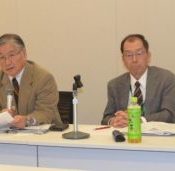
October 27, 2018 Ryukyu Shimpo
(Tokyo) On October 26, 110 administrative law experts from around the country published a statement criticizing the Okinawa Defense Bureau’s submission to the Minister of Land, Infrastructure, Transport and Tourism of a request for review and petition for an injunction based on the Administrative Complaint Review Act as “an abuse of a relief system meant to restore citizens’ rights and a flouting of the rule of law.”
The statement calls on the minister to dismiss the Defense Bureau’s complaint. It explains that the Administrative Complaint Review Act explicitly does not apply to dispositions rendered to administrative organs having a “distinct status,” and criticizes the Defense Bureau’s request for review and petition for an injunction as “an unlawful act.”
The statement questions the fact that the Defense Bureau made its complaint to the Minister of Land, Infrastructure, Transport and Tourism when these are both national administrative organs, and states that “objectivity, impartiality, and fairness, which are particularly required of an agency connected with proceedings, will be impaired.”
In 2015, when the Okinawa prefectural government cancelled the Henoko land reclamation authorization and the Defense Bureau took countermeasures similar to those it has taken in the present instance, the Minister of Land, Infrastructure, Transport and Tourism quickly ordered an injunction, allowing the construction to be resumed; meanwhile, the request for review was withdrawn as a result of an out-of-court settlement in 2016, and during that entire period the minister made no ruling on its lawfulness.
The statement takes this history as evidence that impartiality cannot be expected of the Minister of Land, Infrastructure, Transport and Tourism.
Nagoya University Professor Emeritus Kenji Kamino, Chuo University Professor Tadasu Watari, Waseda University Professor Masanori Okada, and Senshu University Professor Hiroyuki Shirafuji, four of the ten researchers who drew up the statement, held a press conference at the National Diet on October 26.
Professor Kamino explained that many supporters added their names to the statement during the short period following completion of the draft on October 23, stating, “there were many administrative law experts who felt that the situation is truly deplorable. That response is very important.”
Experts published a similar statement when the Defense Bureau submitted a request for review and petition for an injunction based on the Administrative Complaint Review Act to the Minister of Land, Infrastructure, Transport and Tourism after former Governor Takeshi Onaga cancelled the land reclamation authorization in 2015.
(English translation by T&CT and Sandi Aritza)
Go to Japanese
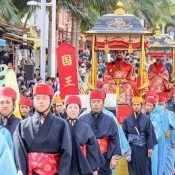
October 28, 2018 Ryukyu Shimpo
The Ryukyu Dynasty Parade was held on Kokusai Street in Naha City on October 28, the second day of the Shuri Castle Festival. Many spectators lined the streets to enjoy the annual procession. Onlookers cheered in amazement and adoration as they took photos of this year’s king and queen who were dressed in vibrantly colored costumes.
The procession of nearly 700 people paraded through Kokusai Street with the king, Hiroyuki Kamiyama and queen, Ayana Nagamine leading the way on palanquins known as uchuus, with traditional performance groups in tow. The extravagant and enchanting reenactment brought the Ryukyu Dynasty era to life, captivating spectators.
Tokio Nimoto, a 59-year-old Naha City resident said with apparent satisfaction, “I got to experience the culture of the Ryukyu Kingdom era and I’m feeling proud of Okinawa all over again.”
(English translation by T&CT and Monica Shingaki)
Go to Japanese
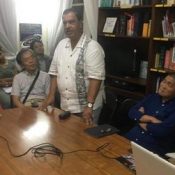
October 30, 2018 Ryukyu Shimpo
By Hiroe Nakagawa and Yoko Tabuki
A plan has begun to connect Egypt and the Hantagawa Community Center in Naha, with the goal of building a community center in Egypt.
In January, the “Global Community Center,” that links the Hantagawa Community Center with Cario, Egypt opened. In September, Hantagawa Community Center President and head of the non-profit organization “10,000-Person Meeting” Shinnosuke Minami visited Egypt.
Egypt, which only recently democratized and is still lacking in citizen autonomy, has been experiencing a decline in the connective tissue between regions.
In order to create a regional hub as well as develop a way to tackle issues together, the desire for a community center that connects them to the world has been increasing.
The representatives connecting Egypt with the Hantagawa Community Center are Mohamed Abdel-Meguid in Egypt and his Okinawan-born wife, Misaki.
Meguid was aboard the Ship for World Youth in 2004, where he studied the differences of each country’s education systems, and took home the thought, “Education leads to the development of the country.”
After returning to Egypt, he took interest in Japanese community centers, and decided he, “wanted to make a community center that would be a good fit for Egypt.”
While living in Okinawa from 2011 through 2015, he studied the practical administration of a community center at Hantagawa Community Center.
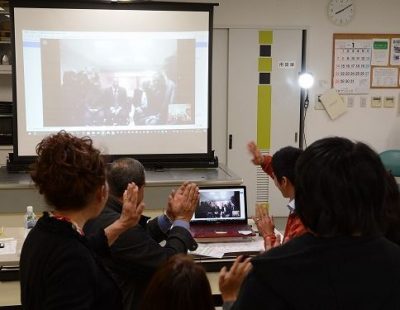
Hantagawa Community Center video conferencing with Egypt over the internet in January 2018 at the Hantagawa Communiy Center in Naha
However, after democratization in Egypt there was a government crackdown on citizen movements and public gatherings.
Since this made it difficult for a regional hub like a Japanese-style community center, the internet-based, “Global Community Center,” that would connect them to world without having to wait for a physical location was became the first step to a community center.
In January, the first meeting of the Global Community Center will take place simultaneously in a private facility in Cairo as well as the Hantagawa Community Center.
There were four lectures where each side shared with the other about their education and culture. In September, Shinnosuke Minami and Yoshitaka Nishiyama, the head of the private organization Town Kitchen, visited universities and private institutions in Egypt to exchange ideas with Meguid as part of an initiative by the Japan Foundation.
In an information session on October 29, Meguid’s wife Misaki said, “It is important to gather and learn as individuals across international borders.”
Minami advised, “As the value of an individual increases, Egypt has a need for a place they can feel a real connection to. A community center that is useful for Egypt could also be said to be groundbreaking for a Japanese community center. It is a chance to reimagine the Japanese community center”
(English translation by T&CT and Sam Grieb)
Go to Japanese

October 25, 2018 Ryukyu Shimpo
On October 24 Japan’s Agency for Cultural Affairs announced that it has nominated ten traditional practices from eight prefectures of Japan that involve wearing masks or costumes to represent deities, including “Pantu” in Miyakojima and “Oga no Namahage” in Akita, to a subsidiary organization of the United Nations Educational Scientific and Cultural Organization (UNESCO) for intangible cultural heritage designation.
UNESCO’s Intergovernmental Committee will meet on Mauritius Island in the Indian Ocean between November 26 and December 1, when the nominated events will likely be incorporated onto the intangible cultural heritage list. Kumiodori, an Okinawan dance style, was granted UNESCO intangible cultural heritage status in November 2010.
If the deity practices are designated this time around, it will be the second instance of Okinawan practices gaining this status.
This is an opportunity for Okinawa to gain global recognition for its precious intangible cultural heritage.
Visiting deity practices are performed at times like the New Year.
In these practices people dress up in masks and costumes to represent deities, walk from house to house and spread joy.
The ten items up for UNESCO designation are already designated as important intangible folk culture assets by Japan, including Miyakojima Pantu practiced in Hirara Shimajiri and Nobaru Ueno in Miyakojima City.
In March last year the Japanese government submitted an application for Pantu for intangible cultural heritage status, because it is a tradition rooted in the region that serves to strengthen community ties, passed down over generations.
According to the Agency for Cultural Affairs, the UNESCO subsidiary organization expressed that it values visiting deity practices, as they demonstrate regional cultural diversity, and is taking steps to protect them.
One of the ten practices being considered is Kagoshima Prefecture’s “Toshidon of Koshiki Island,” which already gained intangible cultural heritage status indiviudually in 2009.
After that, the Japanese government decided to nominate other practices to join the intangible cultural heritage list as a conglomerate item with Toshidon as “visiting deity practices.”
The ten items include Kagoshima’s Namahage, which is similar to Toshidon, and Miyakojima Pantu.
Japan currently has 21 items designated for intangible cultural heritage status.
Since Toshidon has already been designated, other visiting deity practices will be seen as an extension with Toshidon, so even if the practices are incorporated, Japan’s number of items listed on the intangible cultural heritage list will technically not increase.
(English translation by T&CT and Erin Jones)
Go to Japanese
October 6, 2018 Ryukyu Shimpo
On October 5, the Agency for Cultural Affairs (ACA) announced the winners of 2018’s ACA Film Awards, which recognizes outstanding documentary films.
The grand prize was awarded to Cinema Okinawa’s “Mabui Gumi: The History of Immigration Separation to Nouvelle-Calédonie.”
This film tells of the hardships by Okinawans who immigrated to Nouvelle-Calédonie at the beginning of the 20th century.
It won because it “Thoroughly unearths the history of immigration that wasn’t very well known until now.”
Yoshiaki Hongo, 64, who directed “Mabui Gumi” said, “I’m nothing but happy.
I am honored.” Up until now, Hongo has worked on three films that are staged in Okinawa.
Unlike his other films, this winning film not only details historical facts, but also incorporates the feelings of Nouvelle-Calédonie people originally from Okinawa, such as the feelings toward parents, ancestors, and family.
He said, “Nothing can beat how happy I would be if some places said they’d like to show the film again because of this award.”
Former Ryukyu Shimpo Vice President Ken Miki, 78, who is the writer and editor of the film said, “I’d be happy if this serves an opportunity for the history of immigration from Okinawa to Nouvelle-Calédonie to become widely known by many people.”
There were two films that received the award of excellence.
The first was TBS Television’s “The Man Most Feared by U.S. Military, His Name was Kamejiro.” This film follows the life of politician Kamejiro Senaga, who was the symbol of the resistance movement in Okinawa under U.S. military rule.
The second film was SKMTDOC, LLC’s “Ryuichi Sakamoto: CODA.” Produced by a U.S. company, this film closely follows musician Ryuichi Sakamoto.
Both films, which won an award, are related to Okinawa.
The grand prize winner is bestowed two-million yen, while the award of excellence winner receives one-million yen.
On October 25, there was a presentation ceremony, while on October 28, there was a film screening event in Tokyo commemorating the awards.
(English translation by T&CT and Chelsea Ashimine)
Go to Japanese
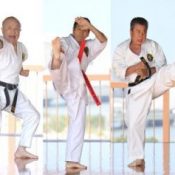
October 26, 2018 Ryukyu Shimpo
As part of the celebration of “Karate Day” on October 25, five of the Okinawa Karate world’s top figures performed a commemorative martial arts demonstration in dedication to the new holiday at the Okinawa Karate Kaikan in Tomigusuku.
In front of an audience of about 200 people from both Okinawa and abroad, the group of Karate heavy-hitters magnificently demonstrated the essence of the world-renown Okinawa Karate, sending the message both far and wide that, “Okinawa is the birthplace of Karate.”
Choko Kiyuna, president of the Okinawa Dento Karatedo Shinkokai, gave opening remarks where after making his formal greeting, he emphasized that Karate, which has helped in the revitalization of Okinawa, was the, “martial art of peace.” He stated that his intention as, “wanting very much for this martial arts demonstration to serve as a cornerstone for peace in the coming year.”
For the demonstration, performances included “Tokuminu-kun” by Masanobu Sakugawa (Shorinji-ryu, Hanshi 9th dan), “Tomari-chintu” by Yoshitaka Taira (Matsubayashi-ryu Hanshi 10th dan), “Kusankudai” by Naonobu Ahagon (Shorin-ryu, Hanshi 10th dan), “Seisan,” by Zempo Shimabukuro (Shorin-ryu, Hanshi 10th dan) and “Maezato nu nunchaku” by Okinawan Intangible Cultural Property holder Masahiro Nakamoto (Kobudo, Hanshi 10th dan.
On October 28, the Karate Day Celebration Martial Arts Demonstration Festival took place on Kokusai Dori in Naha.
(English translation by T&CT and Sam Grieb)
Go to Japanese
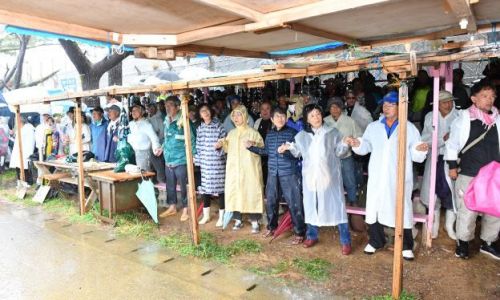








 Webcam(Kokusai Street)
Webcam(Kokusai Street)


